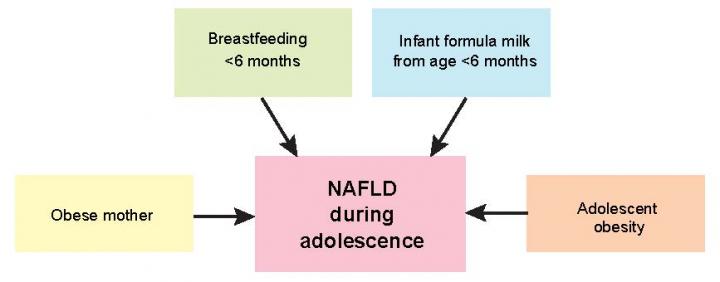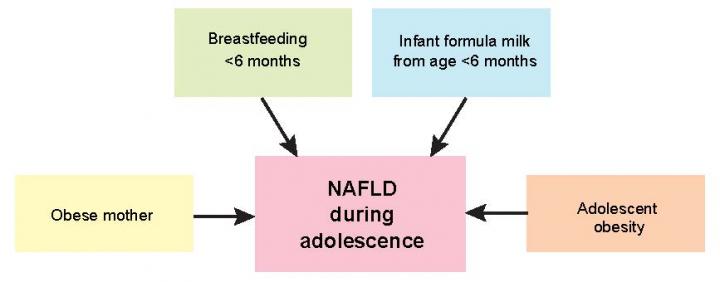
Credit: Journal of Hepatology
Amsterdam, The Netherlands, June 12, 2017 – Infants who were breastfed for less than six months before starting infant formula milk and infants who had mothers who were obese at the start of pregnancy, were much more likely to develop nonalcoholic fatty liver disease (NAFLD) as adolescents, according to a novel study in the Journal of Hepatology.
Non-alcoholic fatty liver disease (NAFLD) is the most common liver disorder in developed countries, affecting up to one in four adults. It occurs when fat accumulates within the liver cells in people who do not consume excessive alcohol and is commonly associated with obesity and insulin resistance. According to the U.S. National Health and Nutrition Examination Survey, NAFLD in adolescents has doubled in the last 20 years.
"There have been studies into the benefits of breastfeeding on other diseases, but there is little information about benefits of breastfeeding linked to liver disease," explained lead investigator Oyekoya T. Ayonrinde, MBBS, of the School of Medicine and Pharmacology, The University of Western Australia, Perth, the Department of Gastroenterology and Hepatology, Fiona Stanley Hospital, Murdoch, and Faculty of Health Sciences, Curtin University, Bentley, Western Australia. "We therefore examined records of Australian adolescents to establish if infant nutrition and maternal factors could be associated with the subsequent diagnosis of NAFLD."
Investigators performed liver ultrasound on more than 1,100 adolescents aged 17 years, who have been followed since before birth as part of the Western Australian Pregnancy (Raine) Cohort study. Records detailing maternal pregnancy and infant feeding were correlated with the presence of NAFLD during late adolescence.
NAFLD was diagnosed in about 15% of the adolescents examined. Ninety-four percent had been breastfed as infants. The duration of breastfeeding before starting supplementary milk was four months in 55% and six months in 40%. Adolescent children of women who were obese at the start of pregnancy were twice as likely to have NAFLD, while those fed infant formula milk before completing six months of breastfeeding had a 40% increased likelihood of NAFLD. Interestingly, offspring of mothers who smoked at the start of pregnancy had a significantly increased risk of NAFLD.
"A healthy weight of the mother and support with initiation and persistence with breastfeeding may have later benefits for the liver in their children," added Dr. Ayonrinde. "This provides additional reasons to support opportunities for women to breastfeed their infants for at least six months while delaying the start of infant formula milk. The important nurturing role of mothers in child health should not be underestimated."
In an accompanying editorial, Anna Alisi, PhD, of the Liver Research Unit, Bambino Gesù Children's Hospital, IRCCS, Rome, Italy, and Pietro Vajro, MD, of the Department of Medicine, Surgery and Dentistry, ''Scuola Medica Salernitana," Unit of Pediatrics, University of Salerno, Baronissi (Sa), Italy, commented, "This elegant observational study by Ayonrinde and colleagues is the first epidemiological evidence for the connection between maternal obesity, breastfeeding, and NAFLD."
"Human breast milk is indeed complex and it may contain various biologically-active constituents with a protective effect upon obesity and obesity-related conditions that remain largely unexplored. The mechanisms for this merit further study."
Dr. Alisi and Dr. Vajro also emphasized the study's findings that there is a significantly increased risk of NAFLD in offspring of mothers who smoked at the start of pregnancy. This substantiates the results of a number of previous studies dealing with the epidemiology of childhood overweight and obesity.
"This study further supports the need to encourage comprehensive healthy lifestyles before and during pregnancy and prolonged exclusive breastfeeding for the long-term health benefits of future generations," they concluded.
###
Media Contact
Sybrand Boer Iwema
[email protected]
31-204-852-781
@elseviernews
http://www.elsevier.com
Related Journal Article
http://dx.doi.org/10.1016/j.jhep.2017.03.029
############
Story Source: Materials provided by Scienmag





